
This volume of the Joseph Smith Papers was edited by Mark Ashurst-Mcgee, David W. Grua, Elizabeth A. Kuehn (who spoke at the FairMormon Conference last year about the Kirtland Crisis of 1837), Brenden W. Rensink, and Alexander L. Baugh. It covers the aftermath of the Kirtland Crisis of 1837 and the move to Far West, the identification of Adam-ondi-Ahman, the formation of the Danites, Hawn’s Mill, the Extermination Order, the stay at Liberty Jail, and the beginning of the building of Nauvoo.
As with all of the volumes, it contains an explanation of the Joseph Smith Papers Project and its methodologies, a volume introduction that gives the general history of the time covered by the volume, section introductions with more detailed history and context of the documents contained in each section, the documents themselves, and reference material such as source notes, timelines, maps, biographical information, organizational charts, and works cited. Each document is introduced by a source note and historical introduction. The document transcripts then contain extensive footnotes with sources and explanations. In some cases, the footnotes are multiple levels deep.
The editors did a good job of explaining controversial events and putting them in context, but also freely admitted when things are unclear. In the first document, the source note discusses Joseph Smith’s plural marriage with Fanny Alger, including Oliver Cowdery’s allegations of adultery. It is explained that “A few individuals who knew JS well recounted later that he had received a revelation about the doctrine of plural marriage as early as 1831, possibly in connection with his work on the revision, or new ‘translation’ of the Bible” (page 12). “After his separation from Alger and the controversy arising from Cowdery’s accusations, JS set aside the practice of plural marriage for several years” (page 13). A later footnote explains “It is unclear precisely what information JS entrusted to Cowdery regarding JS’s relationship with Fanny Alger. Later accounts variously claim that Cowdery performed a marriage ceremony between JS and Alger, was called upon by JS to mediate between JS and Emma Smith after the relationship with Alger was discovered, or had been taught the doctrine of plural marriage privately and took a plural wife contrary to JS’s instructions” (page 91, footnote 454).
The Society of the Daughter of Zion, more commonly known as the Danites, was a controversial organization that comes up many times in this volume. It is introduced in the volume introduction: “several men organized as a private militia known as the Society of the Daughter of Zion – later called the Danites – to defend the church from any remaining internal and external opposition. The intent of the organization was to support the members of the First Presidency and their policies, as well as to defend the church against any future aggression” (page xxiv). Sampson Avard was an early general who “reportedly advocated unquestioned obedience to the First Presidency, lying, stealing, killing, and resistance to the law” (page 306) and has been the source of many anti-Mormon criticisms. Joseph Smith removed him from leadership. “Perhaps embittered by his demotion, Avard was the key witness for the state in the November 1838 hearing” (page 306). There is more information about the Danites and their known leadership in the Organizational Charts section in the back.
Joseph Smith wrote many letters while in jail, but also included here is a letter to him from Emma describing what she is going through: “…No one but God, knows the reflections of my mind and the feelings of my heart when I left our house and home, and allmost all of every thing that we possessed excepting our little Children, and took my journey out of the State of Missouri, leaving you shut up in jail that lonesome prison. But the reflection recollection is more than human nature ought to bear, and if God does not record our sufferings and avenge our wrongs on them that are guilty, I shall be sadly mistaken… The people in this state are very kind indeed, they are doing much more than we ever anticipated they would… But I hope there is better days to come to us yet. Give my respects to all in that place that you respect, and am ever your’s affectionately” (page 340).
Although it is nice to read the actual documents, what is really nice about these volumes are the historical essays and source notes that put them in context, and the annotations that explain each detail of what is encountered in the documents. I can only imagine the hours of research that must have gone into them. Although they are ostensibly intended mainly as a reference for historians, an interested reader can learn an extensive amount of church history from them.
The post Book Review: The Joseph Smith Papers: Documents Volume 6: February 1838 – August 1839 appeared first on FairMormon.
Continue reading at the original source →



